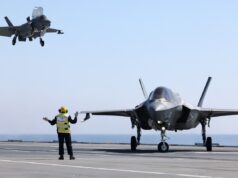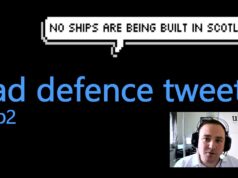Boeing’s test pilots explain the features of the P-8 and describes what people on the ground — and within the aircraft — will see during a demo flight.
“Nine new Boeing P-8 Poseidon Maritime Patrol Aircraft to increase further the protection of our nuclear deterrent and our new aircraft carriers. These aircraft will be based in Scotland and will also have an overland surveillance capability.”
In welcome news for many, the Strategic Defence and Security review confirmed that the United Kingdom will once again operate an effective maritime patrol aircraft.
The P-8 Poseidon, developed by Boeing, is designed to conduct anti-submarine warfare (ASW), anti-surface warfare (ASUW), and shipping interdiction, along with an electronic signals intelligence (ELINT) role. This involves carrying torpedoes, anti-ship missiles and other weapons.
The history of the aircraft dates back to June 2004, when the US Navy announced the selection of the Boeing multimission maritime aircraft, 737 MMA, and awarded a contract to Boeing for the system development and demonstration phase of the programme for the US Navy’s next-generation maritime surveillance aircraft. The aircraft was given the designation P-8A in March 2005.
Poseidon contains up to 7 crew computer consoles in its cabin, has an electro-optical and infrared sensor turret, a maritime surveillance radar and signal intelligence system. Its radar is capable of detection, classification and identification of ships, small vessels and surfaced submarines.
It also has coastal surveillance capability. The P-8 is fitted with advanced magnetic anomaly detection system for submarine tracking. The Poseidon can be used for search and rescue operations.
According to the US Navy, the aircraft in US service carries lightweight Raytheon Mk54 anti-submarine torpedoes. It may also carry other torpedoes, missiles, free-fall bombs, depth charges, mines, or sonbuoys in its weapon bay. Air-to-surface and air-to air missiles, such as Harpoon anti-ship missiles, SLAM or AGM-65 Maverick land attack missiles, and AIM-9 Sidewinders or AIM-120 AMRAAMs will be carried on the underwing hardpoints.
It has been speculated that the UK may elect to integrate Storm Shadow on the aircraft, as it had planned to do with Nimrod prior to the cancellation of the aircraft.
It is expected that up to 117 P-8A MMA aircraft are to be purchased by the US Navy to replace the fleet of 196 P-3C Orion maritime patrol aircraft which are approaching the end of their operational lives. The initial operational capability of P-8A was achieved in November 2013.
In August 2012, it was first reported that Boeing saw the United Kingdom as a market for the P-8, following the cancellation of Nimrod MRA4. After speculation every few months that the UK was going to purchase the aircraft, the UK announced its intention to order nine P-8 aircraft.
P-8 Poseidon Quick Facts, courtesy of Boeing
- For the P-8, Boeing uses a first-in-industry in-line production system that leverages the best of Boeing Commercial and Boeing Defense for development and production.
- The P-8 can fly up to 41,000 feet and travel up to 490 knots.
- P-8 offers higher reliability – the 737 has a 99.8 percent dispatch rate, with more than 4,000 aircraft flying, and 6,600+ orders.
- The P-8 is engineered for 25 years/25,000 hours in the harshest maritime flight regimes, including extended operations in icing environments.
- The P-8 can fly in all flight regimes, and can self-deploy up to 4,500 miles from base without refueling.
- Dual CFM-56B commercial engines each provide 27,000 pounds of thrust, greatly enhancing climb and flight characteristics over turboprop equipped aircraft.
- Each engine is equipped with a 180KVA engine driven generator. Combined with the 90KVA commercial APU, this provides 450KVA of power. P-8 possesses significant growth capacity for equipment with excess onboard power and cooling capacity.
- P-8 has twice the sonobuoy processing capability and can carry 30 percent more sonobuoys than any maritime patrol and reconnaissance aircraft currently flying.
- P-8 has the ability to control unmanned air vehicles (level 2 control-receive) to extend sensor reach.
- P-8 offers commonality with 737 fleet and other military platforms that use the 737 airframe.
The aircraft are to be based at RAF Lossiemouth in Scotland and be used to protect the UK’s nuclear deterrent and new aircraft carriers. The P-8s are also to perform search-and-rescue missions and conduct overland reconnaissance.
Deliveries of the P-8 Poseidon are to begin before 2020, with three being in service before 2020.







